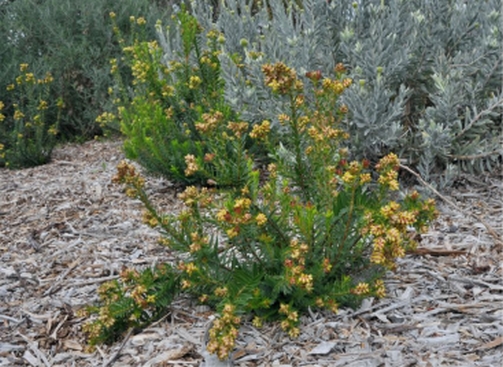Penaea cneorum
Penaea cneorum Meerb.
Family: Penaeaceae
Common names: common brickleaf, common noughts-and-crosses, naughty crosses (Eng.)
Introduction
Penaea cneorum is a lanky shrub with leathery foliage and compact spikes of small yellow flowers that rest upon distinctive greenish-yellow bracts and grow at the tips of the branchlets.

Description
Description
This is a tall, variable, evergreen shrub that grows between 2 and 4 m tall and resprouts after fire. This species has a self-supporting growth form. The leaves are leathery, oval, sessile, with straight points on the tips. These leaves are arranged in opposite pairs, giving a 4-sided look to the stems that are glabrous when young. It has hairless upper branches that are sometimes reddish. The flowers are greenish-yellow, becoming brick-red as they age. They are up to 10 mm long, borne in clusters at the branch tips and have no petals. Flowering is in spring and early summer, from September to January.
There are 5 subspecies of Penaea cneorum that are currently recognized: subsp. cneorum, subsp. gigantea, subsp. lanceolata, subsp. ovata and subsp. ruscifolia, however a molecular study suggests that these divisions may hold no merit and further study may show that they should be recognized as separate species or included with Penaea mucronata.

Conservation Status
Status
Penaea cneorum is a South African endemic. It is not threatened and is, therefore, classified as of Least Concern (LC) in the Red List of South African Plants.
Distribution and habitat
Distribution description
Penaea cneorum is found in the Western Cape, from the Kogelberg and Riviersonderend Mountains to Gqeberha (formerly Port Elizabeth), in the Eastern Cape, occurring among fynbos scrub along stream banks, and in damp areas of the coastal sandstone slopes.

Derivation of name and historical aspects
History
The genus Penaea was named by Carl Linnaeus in 1753 after Pierre Pena (1535–1605), French physician and botanist who was assistant to Matthias de L’Obel, after whom the genus Lobelia is named. The Latin specific epithet cneorum, pronounced suh-nor-um, is derived from a word of Greek origin referring to Daphne-like plants in the Thymelaeaceae, and it is also the name for a genus of shrubs, the spurge olives, in the Rutaceae. This plant was most likely given this species name due to its resemblance to species of Gnidia from the Thymelaeaceae family.
Penaea is a genus of flowering plants in the family Penaeaceae, found in southern South Africa. They have an unusual type of embryo sac development; after two rounds of mitosis, four nuclei are formed at each pole, leading to a mature embryo sac containing four polar groups each with three cells. When found in other taxa, these embryo sacs are termed Penaea-type.
Penaeaceae have been previously placed under Myrtales or close to Thymelaeaceae and in 1894 were included in this family. More recent authors agree on the placement of Penaeaceae in Myrtales, and exclude Thymelaeaceae from this order.
Ecology
Ecology
This species is a resprouter, and will grow back after a fire.
Uses
Use
Species in the Penaeaceae have not been sought-after as horticultural subjects of any note in the past and there are no known magical or medical uses associated with Penaea cneorum. It is also one of those species that have not been cultivated or experimented with, unfortunately, but has good horticultural potential, and is well-suited to fynbos and coastal gardens.

Growing Penaea cneorum
Grow
Penaea cneorum can be propagated from both cuttings and from seeds. Take heel cuttings in autumn or spring, and root them in sterilized multi-trays to avoid diseases and other bacteria.
This plant is best grown in full sun, if grown in a spot that’s too shady it has a habit of losing its leaves. It naturally occurs in damp sites and coastal areas, and therefore prefers to be under moist conditions. Water regularly and fertilize with an organic fertilizer, until the plant is well established.
References
- Bean, A. & Johns, A. 2005. Stellenbosch to Hermanus. South African Wild Flower Guide 5. Botanical Society of South Africa, Cape Town.
- Burman, l. & Bean, A. 1985. Hottentots Hollands to Hermanus. South African Wild Flower Guide 5. Botanical Society of South Africa, Cape Town.
- Casabio, Penaea cneorum. https://casabio.org/taxa/penaea-cneorum. Accessed 18/05/22.
- Dave’s Garden, Botanary, cneorum. http://davesgarden.com/guides/botanary/go/1439/. Accessed 27/06/2022.
- Geoffrey’s plant names explained, Penaea. https://www.plantnames.co.za/species.php?genus=372. Accessed 18/05/2022.
- McDonald, D.J. 1989. Penaea dahlgrenii Rourke – a species with possible horticultural potential. Veld & Flora 75(4): 119-120.
- Modimola, S. 2021. Penaea mucronata L. (Penaeaceae). PlantZAfrica. Online. http://pza.sanbi.org/penaea-mucronata.
- Picture This, Common brickleaf, Penaea cneorum. https://www.picturethisai.com/wiki/Penaea_cneorum.html. Accessed 13/06/2022.
- POSA, Plants of southern Africa online. Penaea. http://posa.sanbi.org/sanbi/Explore. Searched 13/06/2022.
- Raimondo, D., Von Staden, L., Foden, W., Victor, J.E., Helme, N.A., Turner, R.C., Kamundi, D.A. & Manyama, P.A. (eds) 2009. Red list of South African plants. Strelitzia 25. South African National Biodiversity Institute, Pretoria.
- Schonenberger, J. & Conti, E. 2003. Molecular phylogeny and floral evolution of Penaeaceae, Oliniaceae, Rhynchocalycaceae and Alzateaceae (Myrtales). American Journal of Botany 90(2): 293-309.
Credits
Sisanda Velembo
Kirstenbosch National Botanical Garden
July 2022
Acknowledgements: images by Alice Notten.
Plant Attributes:
Plant Type: Shrub
SA Distribution: Eastern Cape, Western Cape
Soil type: Sandy, Loam
Flowering season: Spring, Early Summer
PH: Acid
Flower colour: Green, Red, Yellow
Aspect: Full Sun
Gardening skill: Average
Special Features:
Horticultural zones








Rate this article
Article well written and informative
Rate this plant
Is this an interesting plant?
Login to add your Comment
Back to topNot registered yet? Click here to register.